In 2005-06 it is estimated from the ABS confidentialised data13 that there were around 10.6 million individuals with a non-zero superannuation balance and this represented around $670 billion in superannuation assets. It is estimated that Men with superannuation aged between 15 and 64 (inclusive) own around 66 per cent of superannuation assets14. The mean superannuation balances were estimated to be $70,010, $40,696 and 56,138 for men, women and persons, respectively. These balances are quite similar to those released by the Association of Superannuation Funds of Australia15. The estimated median superannuation balances were $24,500, $13,675 and $18,000 for men, women and persons, respectively. It should be noted that these superannuation balances exclude some age groups, for instance those aged 65 and over. The average and median balances are higher again with these age groups included16. The balances would be higher again if we re-scaled17 to get closer to the Australian Prudential Regulatory Authority aggregates. For instance, average superannuation balances for all persons with superannuation (including those aged 65 and over) are estimated to be $97,569, $57,580 and $78,818 for men, women and persons, respectively after re-scaling. Similarly, median superannuation balances for all persons with superannuation are estimated to be $31,257, $18,412 and $25,006 for men, women and persons, respectively after re-scaling.
Chart 21 and Chart 22 both generally show that mean superannuation balances rise with total income and age. By age and total income18 the mean superannuation balances for men are higher than women. As expected, men and women aged 60-64 enjoy the largest median superannuation balances, $197,098 and $138,526, respectively. Chart 24 shows that around 5 per cent of men and women with superannuation are in this age group. Men and women with total income of $95,000 or more enjoy the largest superannuation balances of $190,090 and $154,332, respectively. Chart 23 shows that around 6 per cent of men and women with superannuation are in this total income group.
Chart 23 shows that the distribution of men and women with superannuation peaks at around 55 per cent for males and females with total income of between $21,601 and $63,000. Average superannuation balances in this income range are $47,946, $37,489 and $42,939 for males, females and persons, respectively. Chart 23 also shows that the percentage of females with superannuation just exceed the percentage of men with superannuation for total income ranges $21,601-$63,000 and below.
Chart 24 shows that the distribution of men and women with superannuation peaks at around 13 per cent for males and females aged 30-34. Average superannuation balances in this age range are $27,284, $21,721 and $24,602 for males, females and persons, respectively. Chart 24 also generally shows that the percentage of females with superannuation exceed the percentage of men with superannuation at each age group, except for 35-39, 55-59 and 60-64.
Chart 25 shows the proportion of those with superannuation as a proportion of those with and without superannuation in the population within total income ranges. It is estimated that coverage peaks at 96 per cent and 98 per cent for men and women, respectively. The peak for men and women is in the $63,601-$95,000 total income range. By age the peaks are 92 per cent and 85 per cent for those aged 30-44 for men and those aged 25-29 for women, respectively. Similarly to Chart 7 and 8, coverage generally increases with total income and declines across age ranges.
Chart 21: Mean superannuation balances by total income19 and gender in 2005-06
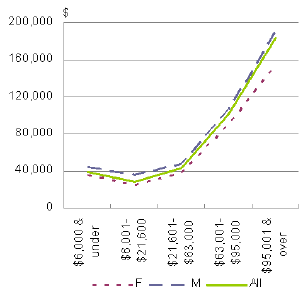
Chart 22: Mean superannuation balances by age and gender in 2005-06
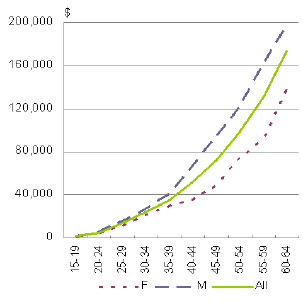
Chart 23: Distribution of those with superannuation by total income and gender in 2005-06
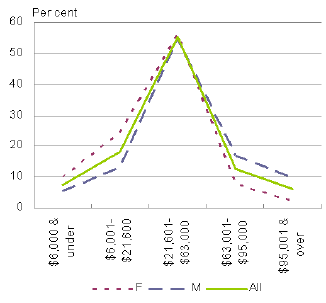
Chart 24: Distribution of those with superannuation by age and gender in 2005-06
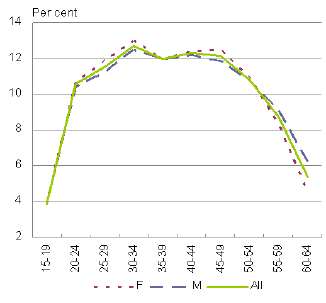
Source: Treasury estimates based on the 2005-06 Survey of Income and Housing (ABS Cat. No. 6541.0). Amounts have not been adjusted to benchmark more closely with the relevant APRA aggregate superannuation assets.
Chart 25: Coverage of males and females with superannuation by total income in 2005-0620
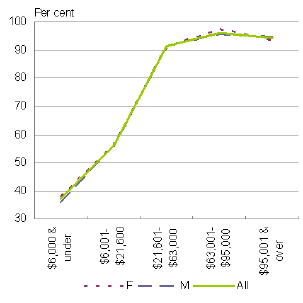
Chart 26: Coverage of males and females with superannuation by age in 2005-06
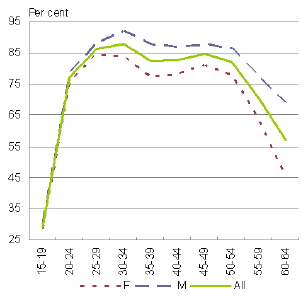
Source: Treasury estimates based on the 2005-06 Survey of Income and Housing (ABS Cat. No. 6541.0).
13 2005-06 Survey of Income and Housing (ABS Cat. No. 6541.0).
14 For those aged between 15 and 64 (inclusive) it is estimated that there were around 10.1 million individuals with a non-zero superannuation balance and this represented around $568 billion in superannuation assets.
15 Retirement savings update, Ross Clare, ASFA, February 2008. ASFA reported that average superannuation balances for those aged 25 to 64 (inclusive) were $69,050, $35,520 and $52,200 for males, females and persons, respectively. It should be noted that these balances were averaged over those with and without superannuation. This is the principal reason for any difference in the averages/medians we calculate compared to those reported by ASFA. The average superannuation balances become $80,946, $47,032 and $64,930 for males, females and persons, respectively if we include only those with some superannuation aged 25 to 64 (inclusive). The ASFA report is also based on the ABS Cat. No. 6541.0.
16 For completeness, average superannuation balances become $78,038, $46,054 and $63,040 for males, females and persons, respectively. These average superannuation balances would be lower if we had computed them for those with and without superannuation.
17 The required re-scaling is 1.250277.
18 The total income definition used here is the total current income from all sources (2005-06 basis). This measure includes salary sacrifice, including supe
rannuation salary sacrifice.
19 The total income definition used here is the total current income from all sources (2005-06 basis). This measure includes salary sacrifice, including superannuation salary sacrifice.
20 Proportions are for those with the variable of interest (a non-zero superannuation balance in this case) as a proportion of those with and without the variable of interest within the same range (either total income or age). The population of those with and without a variable of interest is taken to be the person population aged 65 and under in the 2005-06 Survey of Income and Housing (around 13.5 million persons).